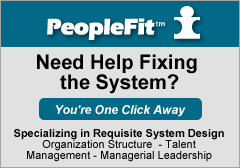Work-Levels Goggles – A Business Strategy Tool
By Michelle Malay Carter on January 2, 2008
 My last post was about work levels.? I gave an example of how sales work?looks different at different levels.? I’ve also said that innovation looks different at different levels.
My last post was about work levels.? I gave an example of how sales work?looks different at different levels.? I’ve also said that innovation looks different at different levels.
Work Level Examples from the World of Recruiting
I was reading Amitai Givertz’s?Recruitomatic Blog which led me to an older?post by Jeff Hunter’s Talent Seeker blog.? In it he describes three different recruiting models, Commodity Recruiting, Value Recruiting, and Experience Recruiting.? Essentially, Jeff Hunter has done an outstanding job of describing what recruiting looks like at different levels.?
I posted Jeff’s recruiting model descriptions below; then, for?your enjoyment,?I put on my work-levels goggles and described what I saw in these models.
One Strategic Significance to Understanding Work Levels
The complexity level of the model or framework an organization adopts (for any function, not just recruiting)?dictates the level of problem solving capability an employee must?have in order to carry out the tasks required by the model, which, in turn, will dictate the appropriate salary range for the employees.?
Using a Level 1 Recruiting model will cost you the least in terms of salaries, but will it allow you to meet your strategic goals?? Aligning organizational structure with strategy is executive level work – finding the ROI sweet spot between staffing a function at a high enough level to meet strategy and paying higher salaries to staff a higher level function.? (More on this tomorrow.)
What Recruiting “Looks Like” at Different?Levels?- Words in quotes from Jeff Hunter
Level 1 or 2 Recruiting Model – Commodity Recruiting
Requires employees with level 1 or 2 problem solving capability
“Commodity Recruiting:? Takes the specification (the job description) posts it on a job board, gets candidate flow, evaluates candidate flow against the spec and then forwards the favorably rated resumes to the hiring manager. Everything in this transaction can either be done by the hiring manager or by an administrative assistant making minimum wage, or be automated (the holy grail of electronic recruiting is matching, which is the final step in recruiting commoditization).”
Looking at?Commodity Recruiting with Work-Levels Goggles:? If this work can be done solely by matching to spec, i.e. following procedures, then this is level one work.? If it requires some data analysis. i.e. picking up multiple bits of information to draw a conclusion about which resumes to forward, it is level two work.
Level?3 or?4 Recruiting Model – Value Recruiting
Requires employees with level?3 or?4 problem solving capability
“Value Recruiting:? Takes the specification, asks probing questions about what is really meant by the description and changes language to fit what is currently acceptable in the market, asks for resumes of previous ?stars? and compares those resumes to the specification, changing the specification as appropriate to more closely match those success profiles, brings specific candidates in against the spec to examine how clear and committed the hiring manager is to the spec, and changes the spec as the process continues to bring the true requirements of the hiring manager and the availability in the market together.”
Looking at?Value Recruiting with Work-Levels Goggles:? Creating a serial pathway and having multiple contingency?pathways established is level 3 work.? This begins to sound like level 4 work due to the statement: “bringing together the requirements of the hiring manager and the availability of the market”.? If these are separate serial pathways that must be integrated to deliver a solution, this is level 4 work.
Level?4 or?5 Recruiting Model – Experience Recruiting
Requires employees with level 4 or 5 problem solving capability
“Experience Recruiting:? Refuses the specification because it will unduly prejudice the truth about what the business needs to succeed, interviews ?stars? as well as ?laggards? to try to identify key cultural, competency and chemistry dynamics that will help describe the perfect candidate, puts together detailed behavioral profile of the target candidate, uses detailed marketing profile techniques to source against a pre-developed grouping of talent (since the experience recruiter will have predicted the broader needs of the client and been actively developing value-for-value relationships in those domains well in advance of the client?s need – perhaps Sumser’s farm system), will bring in specific candidates with specific behavioral profiles and detailed work portfolios to gauge the upper and lower bounds of variation in the specification, marks the specification variances for forward looking business projections, tailors specific work and compensation packages in order to get the most value from the talent, introduces the hiring manager into key talent arenas in order to build the credibility of the client with potential future hires, and periodically report on larger talent trends that the experience recruiter feels will impact the business (the ?what business can we be in?? question).”
Looking at Experience Recruiting with Work-Level Goggles:? There is integration of multiple serial pathways here which is level 4 work, i.e. talent trends, business projections, compensation, talent pipeline, credibility building, business trends, candidate capability assessment, role clarification.? This begins to sound like level 5 work with the introduction of the question, “what business can we be in”.? Optimizing a total business unit to deliver a strategy?is level 5 work.? Defining what business you are in is level five work as well.
Jeff Hunter is clearly a talented, highly-capable recruiter and no doubt a valued business partner to his clients.? He clearly understands work.? Adopting a work levels framework and investing in a pair of work-levels goggles would add a universal measurement tool to his toolbox which would?provide him with?a common language for discussing and aligning work levels and candidate capability.
Potential Competitive Edge
Research shows that 35% of employees are mismatched to their roles in terms of problem solving capability, leaving them either bored or incapable.? A recruiter with a proven process for matching employee capability to level of work would certainly have a competitive edge in a very competitive business.
In high school the geeks wore glasses, in the business world, the geeks wear work-levels goggles.? It’s been said that the geeks will inherit the earth.
Successful leaders have an eye for spotting potential.? Do you see the potential in adopting a work levels framework??
I’m OK.? You’re OK.? Let’s fix the system.
Filed Under Employee Engagement, Executive Leadership, High Potential, Managerial Leadership, Organization Design, Requisite Organization, Strategy, Talent Management
